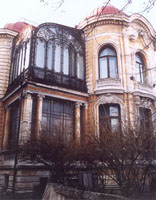|
|
| -
THE NATIONAL MUSEUM OF ANTIQUITIES - |
|
|
|
 |
THE NATIONAL MUSEUM OF
ANTIQUITIES became part of the structure of
the Academy in 1948; it is the second treasury
of valuable cultural pieces of the Romanian
Academy. As in many other European countries,
modern public museums appeared in Romania
through the generous endowments of a handful of
amateurs éclairés who donated their private
collections to the state. Such a donor was, in
1834, Mihalache Ghica, a highly polished
character, brother to Alexandru Ghica, then
Prince of Wallachia.
This collection was the
nucleus of the future National Museum of
Antiquities. Shortly, the Museum became the
beneficiary of all chance archeological
discoveries as well as of those resulting from
planned digs. |
|
|
|
|
In addition, dozens of some of the richest
private collections in the country entered
the Museum’s patrimony both through
donations and acquisitions. The diversity of
these sources accounts for the heterogeneous
character of the Museum, which had in its
bequest objects found on Romanian territory
next to artifacts purchased abroad or of
uncertain origin, objects of widely
different types and from very different
times (divers prehistoric objects, coins
from all eras, works of art or of quotidian
use, from the antiquity down to our time).
The National Museum was a repository for
Egyptian objects and artifacts from Cyprus
and Mycenae, painted Greek vessels, a
curious collection of wristwatches, as well
as many works of religious art removed from
the churches of some monasteries after the
decree of secularization of Alexandru Ioan
Cuza in 1863. At the same time, the Museum
reunited expert connoisseurs of many
different categories of objects belonging to
different times and places of civilization
and culture, and for this reason also
fulfilled the role of a center of
archeological research; indeed its directors
were brilliant personalities of Romanian
academic life from Alexandru Odobescu to
Grigore Tocilescu, Vasile Pârvan, Ion Nestor
and others. Like the Committee of Historical
Monuments, the National Museum of
Antiquities was organized through a special
code which also governed the preservation
and study of ancient monuments in Romania.
|
|
Thus, when in 1948 the National Museum of
Antiquities became subordinate to the
Romanian Academy, and in 1956, a part of the
newly founded Institute of Archeology, these
decisions seemed logical enough. However, in
the following years, the collections
suffered partial transfers to regional
museums as these were being set up or
reorganized. Still, with its heritage of
over 100,000 pieces, in addition to a
valuable and large lapidary and 150,000
numismatic pieces from the Greco-Roman
antiquity and the Middle Ages, the Institute
of Archeology owns one of the most valuable
treasuries of antiquities not only in
Romania but in South Eastern Europe. In
1990, the Presidium of the Romanian Academy
decided it would reopen the National Museum
of Antiquities; to this end, painstaking and
delicate preparations are currently under
way. Educational functions will complement
the scientific role of the collections. The
visitors to the Museum will thus be able to
have an overview of all the cultures on
Romanian territory, from the Paleolithic and
the Neolithic to the bronze and the iron
ages. All traces of the classic Greco-Roman
civilization in ancient Dacia will be
brought together with those found in the
antique sites on the Black Sea, with
archeological discoveries dating from the
era of the Barbarian migrations and from the
Middle Ages, with Egyptian antiquities from
older donations, dating from the third
millenium B.C. to the Hellenistic period,
with Greek vessels from Cyprus and Mycenae
dating from the bronze age, with Italic
objects such as Etruscan pieces and ceramics
in the styles of Apulia and Campania from
the 8th-1st centuries B.C. etc.
|
|
| |
|